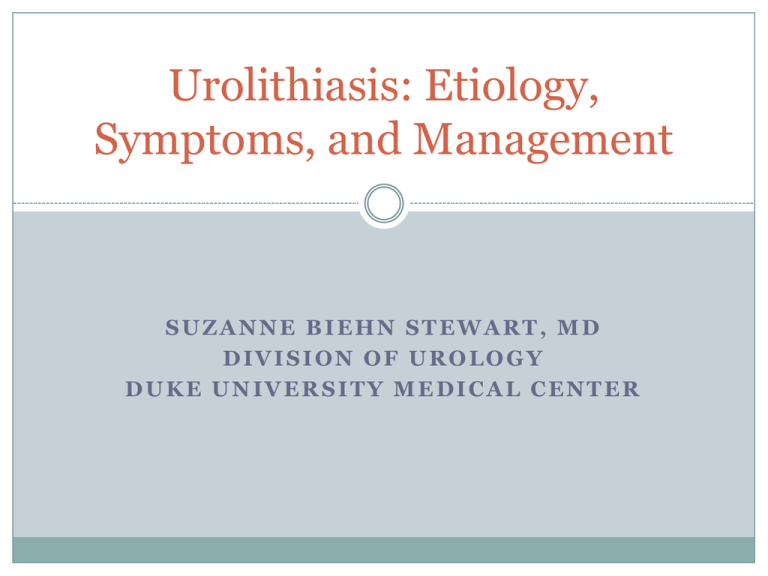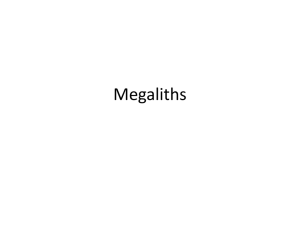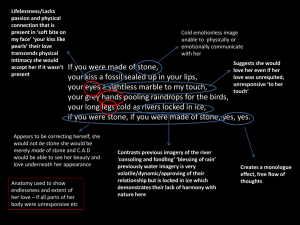Urolithiasis: Etiology, Symptoms, and Management
advertisement

Urolithiasis: Etiology, Symptoms, and Management SUZANNE BIEHN STEWART, MD DIVISION OF UROLOGY DUKE UNIVERSITY MEDICAL CENTER Urinary stones have plagued humans since the beginning of recorded history Initial stones uncovered in mummified remains of Egyptians ~7,000 years ago Overtime, we have made drastic improvements in our understanding of stone formation and treatment strategies Babayan RK et al. “Urinary Calculi and Endourology,” Handbook of Urology, 3rd ed. 2004 1. 2. 3. 4. 5. 6. 7. 8. 9. 10. Risk factors for stone disease Economic implications Various types of stones Causes of stone development Common symptomatology Acute Evaluation tools Differentiate patients that need immediate vs delayed intervention Various options for treatment Treatment complications Recommended follow-up Epidemiology—1 Overall 1-3% of adults are affected in industrialized nations In the US, highest prevalence is in the Southeast (the Stone Belt) Courtesy of Preminger GM. Epidemiology—2 Natural History and Risk Factors Peak incidence age: Race: 30-60 years 4-5x more common in whites than blacks Family history: Body size: 3 fold risk with risk weight Epidemiology—3 Changing Trends Historically…. Stones were 3x more common in males than females Currently…. Males are only 1.3x more likely to form stones than females (2002) Secondary to changes in diet, lifestyle and increased obesity in females Scales et al. 2005 Epidemiology—4 Changing Trends in Hospital Discharges for Renal Calculus by Gender 12.2%, p = .002 21.0%, p = 0.001 Scales et al. 2005 Epidemiology—5 Stones are Common… Annual incidence in males = 1% Lifetime risk in white males = 20% Life long disease Risk of recurrence after first stone: Year 1 10 - 15% Year 5 50 - 60% Year 10 70 – 80% Average of 9 yrs intervening between episodes And Costly… In US, stone disease accounts for > 400,000 hospitalizations annually Epidemiology—6 Economic Implications In 1993, inpatient and outpatient costs estimated$2.39 Billion/year1 By 2050, its estimated that there will be 1.6-2.2 million extra stone cases in the US secondary to global warming Leading to an additional healthcare cost of 0.9—1.3 billion/year2 1Thompson et al. 1995; 2Pearle M. 2o08 Etiology—1 Stone development is complex and multifactorial Causes are specific to the type of stone formed (ie stone composition) > 90% of patients a metabolic etiology can be found General pathophysiology principals: Supersaturation: Urine becomes oversaturated with a type of solute, which then comes out of solution (crystallization) 1. Dehydration, urinary obstruction and stasis Inhibitor deficiency: Urine normally has substances which block crystallization (ie citrate and magnesium) 2. Dietary deficiencies Etiology—2 Influential Factors in Stone Formation Dehydration 1. Major player in majority of stones Geographic location: high temperatures Anatomic obstruction and urinary stasis 3. Metabolic/Urine composition 2. Urinary pH Increased stone forming substances (calcium, oxalate, uric acide) Decreased stone inhibiting substances (citrate and magnesium) Diet 5. Urinary tract infection 4. Urease producing organisms: Proteus, Klebsiella, Pseudomonas, Serratia Etiology—2 Influential Factors in Stone Formation 6. Sedentary lifestyle/immobilization Increased bone reabsorption increases urinary calcium Disease states 7. 1. 2. 3. 4. 5. 6. 7. Sarcoidosis Hyperparathyrodism Inflammatory bowel disease Chronic diarrhea s/p Gastric bypass Cystinuria Gout Medications 8. 1. HIV Protease inhibitors: Indinavir and Nelfinavir Etiology—2 Types of Stones 1. Calcium-based: ~80% all stones Calcium oxalate a. 1. 2. 3. 4. 5. Most common stone formed in industralized nations Most common type of bladder stone Radio-opaque Very difficult to dissolve Dehydration = common influential factor Calcium Dihydrate crystals Monohydrate crystals Etiology—3 Types of Stones Calcium-based: 1. Calcium phosphate b. 2. Calcium phosphate crystals 1. ~10% of calcium stones 2. Influential factors: Hyperparathyroidism, UTI, dehydration Non-calcium-based Uric Acid (8%) a. 1. 2. 3. In pure form radiolucent Form in acidic urine (pH < 6.0) Dissolves with alkalization of urine Etiology—4 Types of Stones 2. Non-calcium-based Uric Acid (8%) a. 4. 5. Dehydration = common influential factor Patients usually have normal plasma and urine uric acid levels Uric acid stone Uric acid crystals Etiology—5 Types of Stones 2. Non-calcium-based Struvite (10%) b. 1. 2. 3. 4. 5. Often called “infectious stones” Associated with UTI Majority of staghorn calculi are struvite composition Form in alkaline urine Radio-opaque Struvite stone Struvite crystal Etiology—6 Types of Stones 2. Non-calcium-based Cystine (1%) c. 1. 2. 3. 4. 5. 6. Caused by cystinuria—homozygous recessive disorder Forms in acidic urine Dissolves with urinary alkalization Radio-opaque Resistant to Extracorporeal Shock Wave Lithotripsy (ESWL) May form staghorns Cystine stone Cystine crystal Etiology—7 Anatomic Locations for Stone Formation Can form and be found anywhere along the urinary tract Kidney 1. Stone nidus typically starts to develop a) Ureter 2. Stone nidus can form here secondary: a) 1. 2. Obstruction—i.e. stricture Foreign object—i.e. stent Bladder 3. Stone nidus can form here secondary: a) 1. 2. 3. Dysfunctional bladder Obstruction—i.e. BPH Foreign object Symptoms—1 Not all patients with stones have symptoms Stones become symptomatic when: 1. Cause obstruction and irritation 2. Typical sites of obstruction: Ureteral Pelvic Junction (UPJ) Ureter crosses over Internal iliac vessels Ureteral Vesical Junction (UVJ) Associated with infection Symptoms—2 Classic symptoms: Obstruction Acute, colicky pain Can be severe May have associated nausea and vomiting Location of pain can suggest location of stone Flank Abdominal Radiate to groin or testicle Irritation urothelial lining Hematuria Gross or microscopic Irritation of bladder lining Lower urinary tract symptoms Frequency Urgency Dysuria If associated with infection Fever Evaluation—1 Laboratory tests: CBC—elevated white blood cell count BMP—elevated creatinine UA—positive nitrites, leukocyte esterase Order Urine culture If febrile—Blood cultures Imaging: Non-contrasted CT 1st line diagnostic test Locate stone Determine stone size Identify signs of obstruction • hydronephrosis and hydroureter KUB, Intravenous pyelogram (IVP), US Evaluation—2 Success of spontaneous stone passage is correlated with: Location of stone: Distal > Proximal Stone size: 95% of stones < 5 mm will pass within 40 days 1Urology Stone width (mm) Approx % stones passed1 1 90% 2 85% 3 83% 4 77% 5 56% 6 41% 7 30% 8 21% 9 3% Mean time to passage2 8 days 11 days 22 days ? 10(6); 1977. Am J Roentgenol 178:101;2002. 2J Urol 162:688; 1999 Evaluation—3 Which patients should undergo…. Trial of Passage (Surveillance) vs. Surgical Intervention Indications for Hospital Admission: Fever Signs of infection 1. 2. a) Elevated WBC Solitary kidney Intractable pain Unable to tolerate fluid secondary to nausea/vomitting Renal deterioration 3. 4. 5. 6. a) Elevated creatinine attributed to obstruction Treatment—1 Trial of Passage (Surveillance) Patient candidates: Afebrile, pain controlled, no overt signs of infection or renal compromise Medical management: Oral hydration Analegesics: tylenol, narcotics Alpha blockers: Tamulosin (Flomax) Relaxes ureteral smooth muscle Increases stone passage rates up to ~ 44% Decreases time to stone passage by ~2-4 days Decreases pain associated with stone passage Re-evaluate with imaging ~4-6 weeks If stone remains….INTERVENTION becomes necessary Treatment—2 Patients with Active Infection Initial treatment: Antibiotics Drainage of kidney Ureteral stent Percutaneous nephrostomy tube Double J ureteral stents Proceed with stone removal after infection has cleared Nephrostomy tube Treatment—3 Treatment strategy based on…. Stone Size and Location Options: 1. 2. 3. 4. 1. 2. Kidney and ureteral stones: Extracorporeal Shock Wave Lithotripsy (ESWL) Percutaneous nephrolithotomy with lithotripsy (PCNL) Ureteroscopy with lithotripsy/extraction Open surgery (rare) Bladder stones: Cystolitholapaxy Cystolithotomy (open surgery) Treatment—4 ESWL Most common 1st line treatment for renal calculi Indications: Non-obstructed renal or ureteral calculi < 1.5-2 cm Contraindications: Pregnancy Coagulopathy AAA (> 4cm) Cystine, infectious stones (relative contraindication) Advantages: Non-invasive Sedation only required Outpatient intervention Disadvantages: Patients MUST pass stone fragments Complications: Steinstrasse 4-9%—may require 2nd intervention Hematoma—renal/retroperitoneal Treatment—5 PCNL Indications: Renal pelvis calculi ~ > 2cm Staghorn calculi Proximal ureteral calculi ~ > 1cm UPJ obstruction Contraindications: Coagulopathy Advantages: High stone free rate Renal stones—95% Ureteral stones—75% Disadvantages: Anesthesia Overnight hospital stay Ureteral stent and/or nephrostomy tube in perioperative period Treatment—6 Complications with PCNL Bleeding 1. Risk of transfusion = 3% Hemodynamically unstable Return to the OR Hemodynamically stable Large diameter nephrostomy tube and clamp tube to tampanode bleeding Nephrostomy tampanode balloon catheter Angiography and embolization Pneumothorax/Hydrothorax 2. Percutaneous access: Above 12th rib—10% risk of fluid in pleura Above 11th rib—10% risk of pneumothorax/hydrothorax Signs/symptoms: Pleuritic chest/flank pain, loss of breath sounds, respiratory distress/desaturation Treatment—6 Complications with PCNL Bowel Injury 3. ~0.2% risk Colonic injury more common Left access Morbidly obese Intraoperative detection: contrast in colon with nephrostogram Postoperative signs: Fecaluria, pneumaturia,peritoneal signs, fever, ileus, leukocystosis Renal pelvis laceration/perforation 4. Can occur with dilation of percutaneous tract Commonly detected intraoperatively Postoperatively: common symptom—flank pain Treatment: Placement of large bore nephrostomy tube until tract closes Treatment—7 Ureteroscopy (URS) Indications: Ureteral and lower pole renal stones Morbid obesity Bleeding diathesis Ectopic or horseshoe kidney Tools (aka toys): Semi-rigid vs. flexible ureteroscope Lithotripsy: laser, pneumatic, electrohydralic, ultrasonic Extraction: stone grasper, basket Advantages: Outpatient procedure High success rate of removal ~95% with Laser lithotripsy of ureteral stones Disadvantages: Anesthesia Possible need for ureteral stent placement Treatment—8 Complications of URS Ureteral false passage 0.4-0.9% 1. Entrance into ureteral orifice Passing guidewire around impacted stone Tx: Stent Ureteral orifice Ureteral perforation 1-15% 2. More common with semi-rigid URS Tx: Stent Avulsion ~0.3% 3. Basketing large stone in proximal or mid-ureter Complete avulsion requires operative repair Ureteral Strictures 0-4% 4. Late complication Increased risk with impacted stone, perforations Extravasation of contrast indicating perforation Follow Up Care—1 Abbreviated Metabolic evaluation First episode, solitary stone, uncomplicated course UA, Ucx, stone analysis, BMP, Ca2+, Phosphorus, uric acid Radiographic imaging Extensive Metabolic evaluation Recurrent episodes, medical conditions alter metabolism, non-calcium based stones Same as abbreviated evaluation plus 24 hr urine collection (~2x): urinary pH, volume, sodium, potassium, citrate, uric acid, magnesium, oxalate, chloride, protein, creatinine, cystine Follow Up Care—2 General Dietary Recommendations Oral fluid intake 1. Keep urine volume 2-3L/day Low sodium diet 3. Low animal protein diet 4. Low oxalate diet 2. Chocolate, tea, spinach, rhubarb, nuts, beets Moderate calcium intake 5. 800-1000 mg/day Specific recommendations based on metabolic evaluation Clinical Scenario—1 64 yo female with no previous medical history presents to the ED with left lower quadrant abdominal pain and fever. On CT, she is found to have diverticulitis and incidentally a 5mm, nonobstructing renal pelvic stone. How do you manage the stone? a) PCNL b) ESWL c) URS d) No immediate intervention necessary Clinical Scenario—2 32 yo male with no past medical history presents to clinic with left abdominal pain, hematuria, temperature of 38.5C, WBC 16. On CT he has a left 7mm mid-ureteral stone. What is the appropriate management? a) Immediate URS b) Trial of passage with flomax, narcotics c) Schedule outpatient ESWL d) Hospital admission, abx, stent Clinical Scenario—3 44 yo female POD #1 left PCNL with no nephrostomy tube develops worsening left flank pain, shortness of breath and shows a declining trend her oxygen saturations. What is the next step? Pain meds, nasal cannula, incentive spirometry b) Notify MD, likely needs CXR— pnuemothorax/hydrothorax c) Notify MD, likely needs CT scan—unidentified renal pelvic perforation d) Notify MD, likely needs nephrostomy tube—obstructing stone a)





